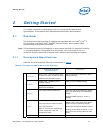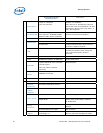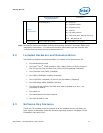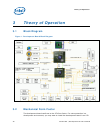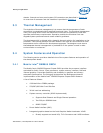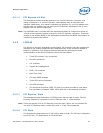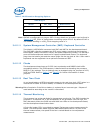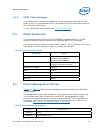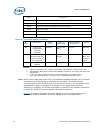
Theory of Operation
316704-001 / Development Kit User’s Manual 23
chassis. Internal and rear panel system I/O connectors are described in Section 3.4.
An overview of connector and slot locations is provided in Chapter 4.
3.3 Thermal Management
The objective of thermal management is to ensure that the temperature of each
component is maintained within specified functional limits. The functional temperature
limit is the range within which the electrical circuits can be expected to meet their
specified performance requirements. Operation outside the functional limit can
degrade system performance and cause reliability problems.
The development kit is shipped with a heatsink thermal solution for installation on the
processor. This thermal solution has been tested in an open-air environment at room
temperature and is sufficient for development purposes. The designer must ensure
that adequate thermal management is provided for if the system is used in other
environments or enclosures.
3.4 System Features and Operation
The following section provide a detailed view of the system features and operation of
the development board.
3.4.1 Mobile Intel
®
GME965 GMCH
The Mobile Intel
®
GME965 Express Chipset GMCH provides the processor interface
optimized for Intel
®
Core
TM
2 Duo processors, system memory interface, DMI and
internal graphics. It provides flexibility and scalability in graphics and memory
subsystem performance. The following list describes the development board’s
implementation of the Mobile Intel
®
GME965 Express Chipset GMCH features.
A list of features follows:
• 1299-ball Micro-FCBGA package
• 533/667/800 MHz Front Side Bus
• 36-bit host bus addressing
• System memory controller (DDR2 implemented)
o Supports Dual Channel and Single Channel operation
o Two 200-pin SODIMM slots
o DDR2 533/667
• Direct Media Interface (DMI)
• Integrated graphics based on the Intel Graphics Media Accelerator X3100
o Directly supports on-board VGA, TV D-Connector and LVDS interfaces.



